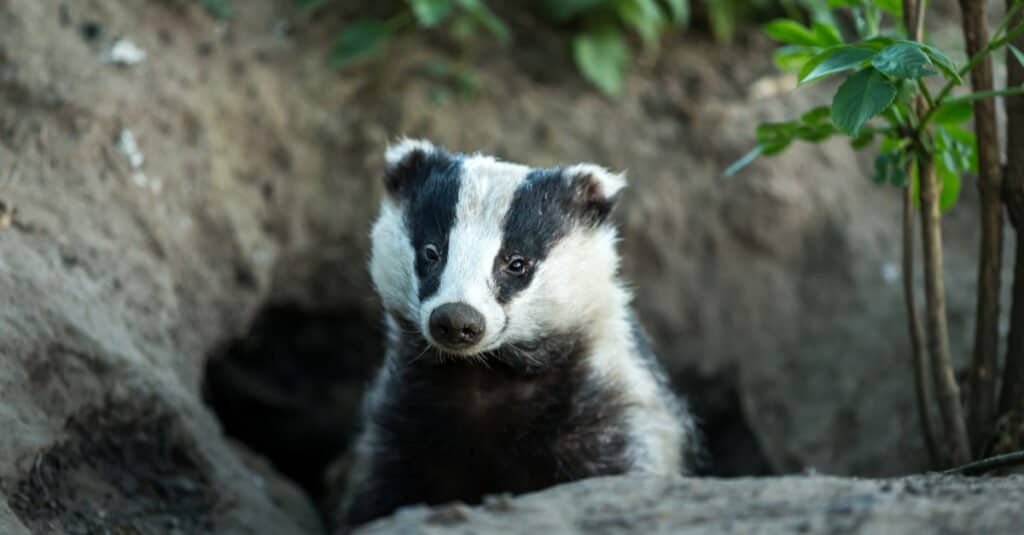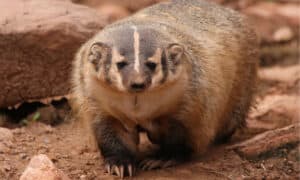Badgers live underground in burrows called setts. These mammals spend much time foraging, focusing on this in the autumn months to prepare for winter. But do they forage at night or during the day? This article explores the sleep behavior of badgers and answers the question, are badgers nocturnal or diurnal?
Badgers are Nocturnal

Badgers are nocturnal, with habitat elements like the temperature and season influencing their activity schedules.
©Coatesy/Shutterstock.com
These mammals are active during the nighttime and sleep during the day. Badgers leave their setts to start their nocturnal activities. After emerging from their setts, they first sniff the air in search of potential danger. Then they follow routes along their territory to forage for food. Badgers are social animals and enjoy spending time with each other.
Cubs enjoy playing by chasing and tumbling with each other, and adult badgers often join in the play. Badgers also groom each other and leave scent marks on group members for recognition purposes. They use the glands beneath their tails to secrete this marking scent.
Even Nocturnal Badger Activity Changes with the Seasons
On average, badgers leave their setts at 7 p.m. and return around 4 a.m. for nocturnal foraging They are most active between 8 p.m. and 3 a.m., so their daily activities average eight hours of their day. Their daily activity is greatly affected by the temperature. In winter, badgers will not hibernate but enter a state of torpor. On average, the badger will be inactive for 96 days each year.
Badgers increase their nocturnal activity in late winter and early spring when the mating season begins. During summer, badgers are active around their setts and feeding locations. During autumn, badgers’ activity increases as they focus on feeding and building up their fat reserves to prepare for winter. Their body weight nearly doubles during autumn.
But this fattening process and activity also depends on the temperature in their environment. Badgers in warmer climates are generally active throughout the year. They do not pick up as much weight in autumn as badgers in colder climates. In contrast, badgers that live in colder climates almost double their weight during autumn and are inactive for as many as six months of the year.
Badgers do not Hibernate

Instead of hibernating, badgers enter a state or torpor.
©Jonathunder, CC BY-SA 3.0, via Wikimedia Commons – License
Badgers do not hibernate but instead enter a state of torpor. The state of inactivity is when the animal reduces its metabolic rate and body temperature to conserve energy. Badgers prepare for this phase by building up their fat reserves during autumn. These animals build up their fat reserves to an impressive 31% of their body weight by the time winter starts.
Their fat reserves then reduce from November to March during the colder months. Badgers reduce their heart rate by roughly 50% and drop their body temperature from an average of 100 degrees Fahrenheit to 84 degrees Fahrenheit. The length of torpor cycles is approximately 29 hours.
It takes 15 hours to enter the state of inertia before remaining in it for eight hours. When awake, the nocturnal badger may leave its sett to forage. The badger will then take six hours to awaken fully. A study conducted from 1977 to 1978 found that badgers reduced their above-ground activity by 93% between November and February.
Nocturnal Badgers Sleep in Setts
Badgers build their homes which are called setts. Setts are like burrows, which badgers create by using their strong limbs and claws to dig. Setts have interconnected tunnels and caves where badgers sleep, store their food, and excrete. These small mammals are highly social and live in groups known as cetes or clans. These groups live in the same territory and setts.
Setts range from 22 to 109 yards, and some can be occupied for decades. The size of the sett depends on the type of soil and the number of members in the group. Although badgers share setts, each has a primary sett where they breed and sleep.
Badgers use straw, bracken, and dry leaves as bedding in their burrows. Badgers collect the materials with their claws. Either they will leave bundles of these mediums outside their setts to dry or bring them inside if there is enough storage space.
Otherwise, they pile up their collections to replace those they use, as necessary. Badgers also often have a scratching tree nearby their sett. They use these scratching trees to sharpen their claws. Sometimes, badgers co-habit with animals like foxes or rabbits in their large setts.
Nocturnal Badgers do not have Good Night Vision

Despite being nocturnal, badgers don’t have good night vision.
©Warren Metcalf/Shutterstock.com
Although these animals are nocturnal, they do not have good night vision. Many nocturnal animals have large eyes that allow more light to enter so they can see better at night. However, badger eyes do not show this degree of evolution. Instead, they have small eyes and poor night vision. The reason for this may be that badgers live underground. Living underground means that there are many dust and dirt particles. It also means that they typically only need to see what is in the immediate environment.
But to compensate for their tiny eyes, badgers have a tapetum. As light passes through their retinas, it is reflected by the tapetum. The eye then uses this reflected light to see well. Tapetum, being reflective, cause the shine we see in animals’ eyes when they are exposed to light.
Because of their poor vision, nocturnal badgers rely on their strong sense of smell and hearing. According to Ernest Neal, who wrote The Badger, “the sense of smell in badgers is extraordinarily well developed and is undoubtedly their most important sense.” According to Vladimir Geptner, who wrote Mammals of the Soviet Union, “Its hearing is no sharper than that of the human.” A superior sense of smell then makes up what the badger lacks in vision and hearing acuities.
Nocturnal vs. Diurnal: What’s The Difference?
Navigate to Nocturnal vs. Diurnal: What’s The Difference? for further information about the nocturnal and diurnal phenomenon in various living creatures.
Up Next
The photo featured at the top of this post is © Coatesy/Shutterstock.com
Sources
- Biodiversity Library, Available here: https://www.biodiversitylibrary.org/item/100156#page/11/mode/1up
- Research Gate, Available here: https://www.researchgate.net/publication/227715806_Annual_and_circadian_activity_patterns_of_badgers_Meles_meles_in_Bialowieza_Primeval_Forest_eastern_Poland_compared_with_other_Palaearctic_populations/link/5ed5d6d54585152945280065/download
- University of Chicago Press Journal, Available here: https://www.journals.uchicago.edu/doi/abs/10.1086/physzool.54.3.30159941
- Journals, Available here: https://journals.plos.org/plosone/article?id=10.1371/journal.pone.0242586
Thank you for reading! Have some feedback for us? Contact the AZ Animals editorial team.






